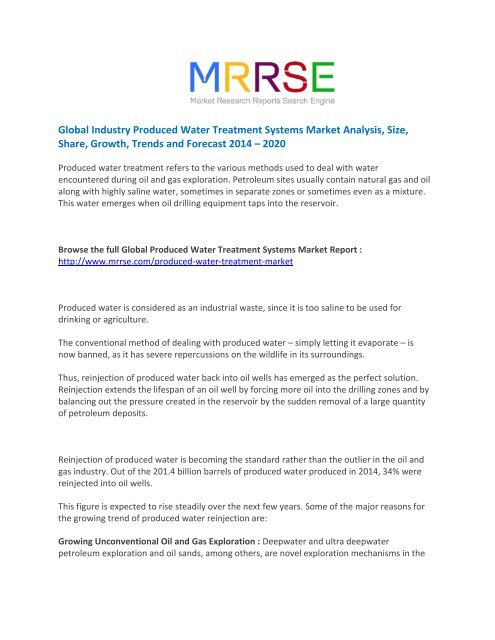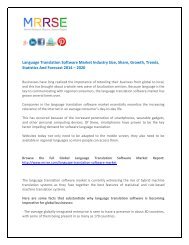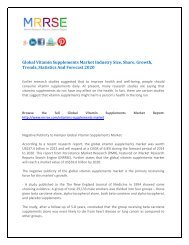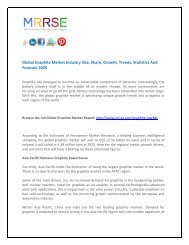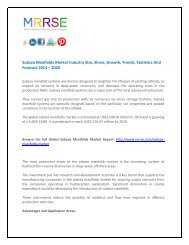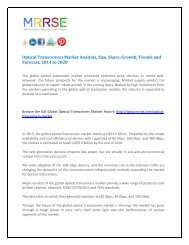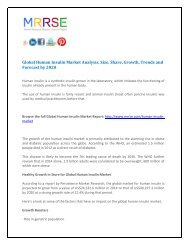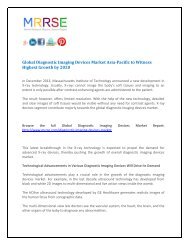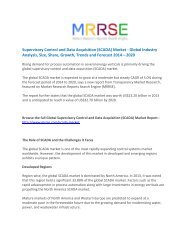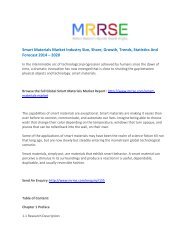Global Industry Produced Water Treatment Systems Market Analysis, Size, Share, Growth, Trends and Forecast 2014 – 2020.pdf
MRRSE.Com announces addition of new report"Global Industry Produced Water Treatment Systems Market: Analysis, Size, Share, Growth, Trends and Forecast 2014 - 2020"to its database
MRRSE.Com announces addition of new report"Global Industry Produced Water Treatment Systems Market: Analysis, Size, Share, Growth, Trends and Forecast 2014 - 2020"to its database
Create successful ePaper yourself
Turn your PDF publications into a flip-book with our unique Google optimized e-Paper software.
<strong>Global</strong> <strong>Industry</strong> <strong>Produced</strong> <strong>Water</strong> <strong>Treatment</strong> <strong>Systems</strong> <strong>Market</strong> <strong>Analysis</strong>, <strong>Size</strong>,<br />
<strong>Share</strong>, <strong>Growth</strong>, <strong>Trends</strong> <strong>and</strong> <strong>Forecast</strong> <strong>2014</strong> <strong>–</strong> 2020<br />
<strong>Produced</strong> water treatment refers to the various methods used to deal with water<br />
encountered during oil <strong>and</strong> gas exploration. Petroleum sites usually contain natural gas <strong>and</strong> oil<br />
along with highly saline water, sometimes in separate zones or sometimes even as a mixture.<br />
This water emerges when oil drilling equipment taps into the reservoir.<br />
Browse the full <strong>Global</strong> <strong>Produced</strong> <strong>Water</strong> <strong>Treatment</strong> <strong>Systems</strong> <strong>Market</strong> Report :<br />
http://www.mrrse.com/produced-water-treatment-market<br />
<strong>Produced</strong> water is considered as an industrial waste, since it is too saline to be used for<br />
drinking or agriculture.<br />
The conventional method of dealing with produced water <strong>–</strong> simply letting it evaporate <strong>–</strong> is<br />
now banned, as it has severe repercussions on the wildlife in its surroundings.<br />
Thus, reinjection of produced water back into oil wells has emerged as the perfect solution.<br />
Reinjection extends the lifespan of an oil well by forcing more oil into the drilling zones <strong>and</strong> by<br />
balancing out the pressure created in the reservoir by the sudden removal of a large quantity<br />
of petroleum deposits.<br />
Reinjection of produced water is becoming the st<strong>and</strong>ard rather than the outlier in the oil <strong>and</strong><br />
gas industry. Out of the 201.4 billion barrels of produced water produced in <strong>2014</strong>, 34% were<br />
reinjected into oil wells.<br />
This figure is expected to rise steadily over the next few years. Some of the major reasons for<br />
the growing trend of produced water reinjection are:<br />
Growing Unconventional Oil <strong>and</strong> Gas Exploration : Deepwater <strong>and</strong> ultra deepwater<br />
petroleum exploration <strong>and</strong> oil s<strong>and</strong>s, among others, are novel exploration mechanisms in the
oil <strong>and</strong> gas industry <strong>and</strong> these are supported by the increase in oil production brought about<br />
by produced water reinjection.<br />
Rising Oil to <strong>Water</strong> Ratio in Existing Oil Wells : Due to relentless oil production for decades,<br />
existing oil wells in many parts of the world have started to run dry. As a result, the amount of<br />
oil, with respect to the amount of produced water encountered, is decreasing. Though it may<br />
seem counterintuitive, the solution to this problem is more injection of produced water. This<br />
will draw out more oil to the drilling zones <strong>and</strong> increase the output of existing oil wells.<br />
<strong>Water</strong> Scarcity <strong>and</strong> Regulatory Support : As mentioned before, the environmental impact of<br />
evaporation of produced water is enormous. As a result, oil <strong>and</strong> gas producers are now<br />
obliged to deal with produced water in a way that’s not dangerous to the environment or any<br />
wildlife in the vicinity of the oil drilling zones.<br />
This has led to the growing application of produced water reinjection, as it’s the simplest way<br />
of complying with these regulations. Scarcity of fresh water to use for reinjection is also one<br />
of the important reasons for the spread of reinjection.<br />
Send An Enquiry: http://www.mrrse.com/enquiry/139<br />
Table of Contents:<br />
1. <strong>Global</strong> <strong>Produced</strong> <strong>Water</strong> <strong>Treatment</strong> <strong>Systems</strong> <strong>Market</strong> <strong>–</strong> Executive Summary<br />
2. <strong>Global</strong> <strong>Produced</strong> <strong>Water</strong> <strong>Treatment</strong> <strong>Systems</strong> <strong>Market</strong> <strong>–</strong> Acronyms <strong>and</strong> Assumptions<br />
3. <strong>Global</strong> <strong>Produced</strong> <strong>Water</strong> <strong>Treatment</strong> <strong>Systems</strong> <strong>Market</strong> <strong>–</strong> Research Methodology<br />
4. <strong>Global</strong> <strong>Produced</strong> <strong>Water</strong> <strong>Treatment</strong> <strong>Systems</strong> <strong>Market</strong> Taxonomy<br />
5. <strong>Global</strong> GDP & Energy Dem<strong>and</strong> Outlook<br />
5.1. <strong>Global</strong> GDP forecast<br />
5.2. <strong>Global</strong> Energy Dem<strong>and</strong> by Source Type
6. <strong>Global</strong> Crude Oil <strong>and</strong> Natural Gas Production Outlook<br />
6.1. <strong>Global</strong> Oil & Natural Gas Production Outlook<br />
6.1.1. <strong>Global</strong> Onshore <strong>and</strong> Offshore Crude Oil Production<br />
6.1.2. <strong>Global</strong> Onshore <strong>and</strong> Offshore Natural Gas Production Outlook<br />
6.2. Regional Oil & Natural Gas Production Outlook<br />
7. <strong>Produced</strong> <strong>Water</strong> Production Outlook<br />
7.1. What is <strong>Produced</strong> <strong>Water</strong>?<br />
7.2. <strong>Water</strong>:Oil Ratio & <strong>Water</strong>:Natural Gas Ratio<br />
7.3. <strong>Global</strong> <strong>Produced</strong> <strong>Water</strong> Production<br />
7.4. <strong>Global</strong> <strong>Produced</strong> <strong>Water</strong> Production from Oil by Source<br />
7.4.1. <strong>Global</strong> Onshore <strong>Produced</strong> <strong>Water</strong> Production from Oil<br />
7.4.2. <strong>Global</strong> Offshore <strong>Produced</strong> <strong>Water</strong> Production from Oil<br />
7.5. <strong>Global</strong> <strong>Produced</strong> <strong>Water</strong> Production from Natural Gas by Source<br />
7.5.1. <strong>Global</strong> Onshore <strong>Produced</strong> <strong>Water</strong> Production from Natural Gas<br />
7.5.2. <strong>Global</strong> Offshore <strong>Produced</strong> <strong>Water</strong> Production from Natural Gas<br />
7.6. <strong>Global</strong> <strong>Produced</strong> <strong>Water</strong> Production by Region<br />
7.6.1. North America <strong>Produced</strong> <strong>Water</strong> Production Outlook<br />
7.6.2. Europe <strong>Produced</strong> <strong>Water</strong> Production Outlook<br />
7.6.3. Asia Pacific <strong>Produced</strong> <strong>Water</strong> Production Outlook<br />
7.6.4. MEA <strong>Produced</strong> <strong>Water</strong> Production Outlook<br />
7.6.5. Latin America <strong>Produced</strong> <strong>Water</strong> Production Outlook
8. <strong>Global</strong> <strong>Produced</strong> <strong>Water</strong> Volume by End-use<br />
8.1. North America <strong>Produced</strong> <strong>Water</strong> Volume by End-use<br />
8.1.1. North America <strong>Produced</strong> <strong>Water</strong> Onshore Reinjection Volume<br />
8.1.2. North America <strong>Produced</strong> <strong>Water</strong> Offshore Reinjection Volume<br />
8.1.3. North America <strong>Produced</strong> <strong>Water</strong> Disposal Volume<br />
8.2. Europe <strong>Produced</strong> <strong>Water</strong> Volume by End-use<br />
8.2.1. Europe <strong>Produced</strong> <strong>Water</strong> Onshore Reinjection Volume<br />
8.2.2. Europe <strong>Produced</strong> <strong>Water</strong> Offshore Reinjection Volume<br />
8.2.3. Europe <strong>Produced</strong> <strong>Water</strong> Disposal Volume<br />
8.3. Asia Pacific <strong>Produced</strong> <strong>Water</strong> Volume by End-use<br />
8.3.1. Asia Pacific <strong>Produced</strong> <strong>Water</strong> Onshore Reinjection Volume<br />
8.3.2. Asia Pacific <strong>Produced</strong> <strong>Water</strong> Offshore Reinjection Volume<br />
8.3.3. Asia Pacific <strong>Produced</strong> <strong>Water</strong> Disposal Volume<br />
8.4. MEA <strong>Produced</strong> <strong>Water</strong> Volume by End-use<br />
8.4.1. MEA <strong>Produced</strong> <strong>Water</strong> Onshore Reinjection Volume<br />
8.4.2. MEA <strong>Produced</strong> <strong>Water</strong> Offshore Reinjection Volume<br />
8.4.3. MEA <strong>Produced</strong> <strong>Water</strong> Disposal Volume<br />
8.5. Latin America <strong>Produced</strong> <strong>Water</strong> Volume by End-use<br />
8.5.1. Latin America <strong>Produced</strong> <strong>Water</strong> Onshore Reinjection Volume<br />
8.5.2. Latin America <strong>Produced</strong> <strong>Water</strong> Offshore Reinjection Volume<br />
8.5.3. Latin America <strong>Produced</strong> <strong>Water</strong> Disposal Volume<br />
9. <strong>Produced</strong> <strong>Water</strong> <strong>Treatment</strong> Technology Overview
9.1. <strong>Treatment</strong> Technology by Type<br />
9.1.1. Primary <strong>Treatment</strong><br />
9.1.2. Secondary <strong>Treatment</strong><br />
9.1.3. Tertiary <strong>Treatment</strong><br />
9.2. <strong>Global</strong> <strong>Produced</strong> <strong>Water</strong> <strong>Treatment</strong> Technology TMAP <strong>Analysis</strong><br />
10. <strong>Global</strong> <strong>Produced</strong> <strong>Water</strong> <strong>Treatment</strong> <strong>Systems</strong> <strong>Market</strong> by Value<br />
10.1. <strong>Global</strong> <strong>Produced</strong> <strong>Water</strong> <strong>Treatment</strong> <strong>Systems</strong> <strong>Market</strong> <strong>Share</strong> by Technology<br />
10.2. <strong>Global</strong> <strong>Produced</strong> <strong>Water</strong> <strong>Treatment</strong> <strong>Market</strong> by Region<br />
10.2.1. North America <strong>Produced</strong> <strong>Water</strong> <strong>Treatment</strong> <strong>Systems</strong> <strong>Market</strong> by Technology<br />
10.2.2. Europe <strong>Produced</strong> <strong>Water</strong> <strong>Treatment</strong> <strong>Systems</strong> <strong>Market</strong> by Technology<br />
10.2.3. Asia Pacific <strong>Produced</strong> <strong>Water</strong> <strong>Treatment</strong> <strong>Systems</strong> <strong>Market</strong> by Technology<br />
10.2.4. MEA <strong>Produced</strong> <strong>Water</strong> <strong>Treatment</strong> <strong>Systems</strong> <strong>Market</strong> by Technology<br />
10.2.5. Latin America <strong>Produced</strong> <strong>Water</strong> <strong>Treatment</strong> <strong>Systems</strong> <strong>Market</strong> by Technology<br />
11. <strong>Global</strong> <strong>Produced</strong> <strong>Water</strong> <strong>Treatment</strong> System <strong>Market</strong> - Competitive L<strong>and</strong>scape<br />
11.1. <strong>Global</strong> <strong>Produced</strong> <strong>Water</strong> <strong>Treatment</strong> System <strong>Market</strong> <strong>–</strong> <strong>Market</strong> Offerings<br />
11.2. <strong>Global</strong> <strong>Produced</strong> <strong>Water</strong> <strong>Treatment</strong> System <strong>Market</strong> <strong>–</strong> Competitive Dashboard<br />
11.3. <strong>Global</strong> <strong>Produced</strong> <strong>Water</strong> <strong>Treatment</strong> System <strong>Market</strong> <strong>–</strong> Competitive Benchmarking<br />
Latest Report:<br />
Parabens <strong>Market</strong> - <strong>Global</strong> <strong>Industry</strong> Expert Opinions <strong>Analysis</strong>, Emerging Opportunities,<br />
<strong>Market</strong> <strong>Size</strong>, <strong>Share</strong>, <strong>Growth</strong> Drivers, <strong>Market</strong> <strong>Trends</strong>, Statistics And <strong>Forecast</strong> 2015 <strong>–</strong> 2020
http://www.mrrse.com/parabens-market<br />
Description:<br />
Para-hydroxybenzoic acid is commonly abbreviated using the term parabens. Parabens belong<br />
to the family of alkyl esters of para-hydroxybenzoic acid. Parabens mainly differ in the para<br />
position in the benzene ring due to various chemical substitutions.<br />
There are various types of parabens or para-hydroxybenzoic acid available. However,<br />
methylparaben, ethylparaben, propylparaben, butylparaben, <strong>and</strong> benzylparaben are the<br />
widely marketed parabens.<br />
About Us:<br />
<strong>Market</strong> Research Reports Search Engine (MRRSE) is an industry-leading database of market<br />
intelligence reports.<br />
Headquartered in New York, U.S., MRRSE is driven by a stellar team of research experts <strong>and</strong><br />
advisors trained to offer objective advice.<br />
Our sophisticated search algorithm returns results based on the report title, geographical<br />
region, publisher, or other keywords.<br />
MRRSE partners exclusively with leading global publishers to provide clients single-point<br />
access to top-of-the-line market research. MRRSE’s repository is updated every day to keep its<br />
clients ahead of the next new trend in market research, be it competitive intelligence, product<br />
or service trends or strategic consulting.<br />
Contact<br />
State Tower<br />
90, State Street<br />
Suite 700<br />
Albany, NY - 12207<br />
United States
Telephone: +1-518-618-1030<br />
Email: sales@mrrse.com<br />
Website: http://www.mrrse.com/


